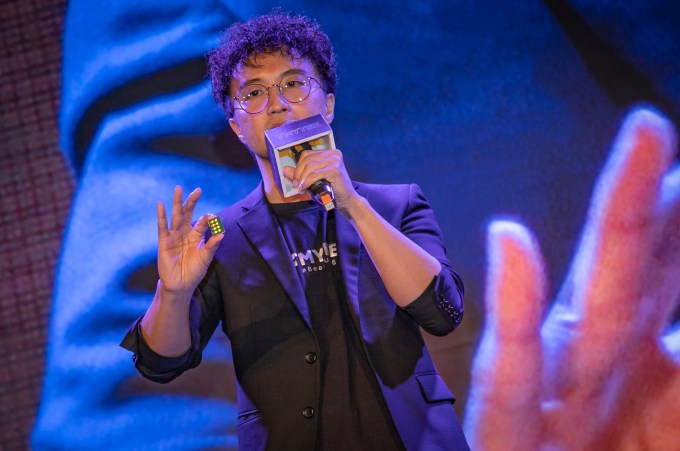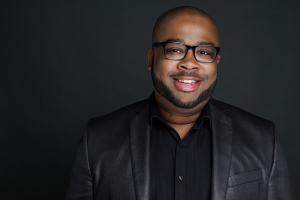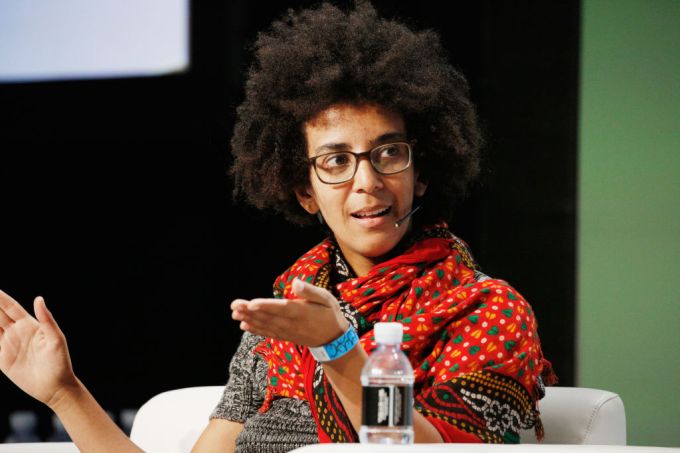- January 2, 2021
- by:
- in: Blog
Welcome back to This Week in Apps, the weekly TechCrunch series that recaps the latest in mobile OS news, mobile applications and the overall app economy. The app industry is as hot as ever, with a record 204 billion total downloads and $120 billion in global consumer spend in 2019. Not including Chinese third-party app stores, iOS and
Welcome back to This Week in Apps, the weekly TechCrunch series that recaps the latest in mobile OS news, mobile applications and the overall app economy.
The app industry is as hot as ever, with a record 204 billion total downloads and $120 billion in global consumer spend in 2019. Not including Chinese third-party app stores, iOS and Android users in 2020 downloaded 130 billion apps and spent a record $112 billion. In 2019, people spent three hours and 40 minutes per day using apps, rivaling TV.
Due to COVID-19, time spent in apps jumped 25% year-over-year on Android. Apps aren’t just a way to pass idle hours — they’re also a big business. In 2019, mobile-first companies had a combined $544 billion valuation, 6.5x higher than those without a mobile focus.
This week (after a week off for the holidays), we’re taking a look at holiday app store spending, how the Chinese gaming licensing rules have impacted the App Store, Apple’s move to ban a party app that could have helped spread COVID, and the collaborative musical created by TikTok users, among other things.
Top Stories
Christmas Day app spending grows 35% year-over-year
Global app spending didn’t seem to be impacted by the pandemic in 2020, according to data from Sensor Tower. The firm reports that consumers spent $407.6 million in apps from the iOS App Store and Google Play on Christmas Day, 34.5% from the $303 million spent in 2019. The majority of the spending was on mobile games, up 27% year-over-year to $295.6 million. Tencent’s Honor of Kings led the games category, while TikTok led non-game apps with $4.7 million in spending on Christmas Day.
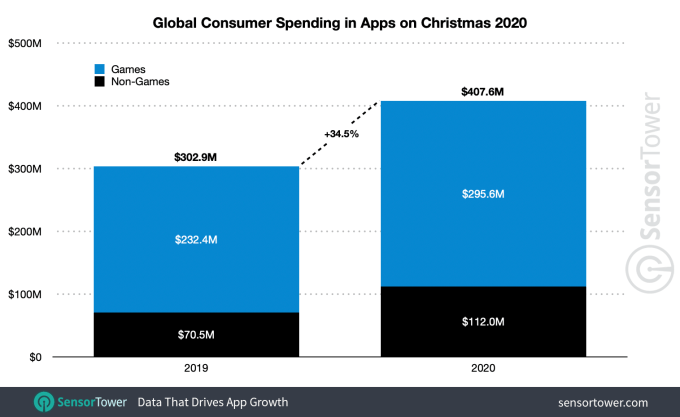
Image Credits: Sensor Tower
As in prior years, Apple accounted for the majority of the spending, or 68.4% ($278.6M) vs Google Play’s $129M. The spending was led by the U.S., who accounted for ~$130 million of the total
Apple takes a stand on pandemic parties
Apple’s App Store Review guidelines don’t specifically detail how the company will handle apps that could contribute to the spread of COVID-19, but Apple found a way to draw the line when it came to a social app that encouraged unsafe gatherings. This past week, Apple banned the app Vybe Together, which had allowed people to locate “secret” indoor house parties in their area, sometimes including those held in violation of state guidelines.
NYT reporter Taylor Lorenz first called attention to the problem with a tweet. The app had been posting to TikTok to gain attention, but its account has since been removed. Following its removal, the company defended itself by saying that it was only meant for small get-togethers and the founder lamented being “canceled by the liberal media.”
There’s no good defense, really, for the unnecessary and ill-timed promotion of an app that encouraged people from different households to gather, which spreads COVID. And what the founder seemed to not understand, by nature of his recent tweets and statements on the app’s website, is that many cities and states also already prohibit small private gatherings of varying degrees, including those he believes are fine, like small parties in folks’ “own apartments with people in your area.”
The U.S. is coping with 346,000 COVID deaths, and in New York, where the app was promoting NYE parties, 74% of all COVID-19 cases from Sept.-Nov. 2020 have been linked to private gatherings.
The media may have reported on what the app was doing, but ultimately the decision to “cancel” it was Apple’s. And it was the correct one.
Apple removes 39K games from its China App Store.
Apple on Thursday, Dec. 31, 2020 removed 39,000+ games from China App Store. This was the biggest removal of games in a single day, Reuters reported, citing data from Qimai.
iOS games have long been required to obtain a Chinese gaming license in order to operate in the country, but Apple skirted this rule for years by hosting unlicensed titles even as Android app stores complied. Apple began to enforce the rule in 2020 and gave publishers a Dec. 31, 2020 deadline to obtain the license — a process that can be tedious and time-consuming.
Clearly, a large number of publishers were not able to meet the deadline. Included in the new sweep were Ubisoft’s Assassin’s Creed Identity and NBA 2K20. Qimai says only only 74 of the top 1,500 paid games remained following the removals. To date, Apple purged more than 46,000 titles from the China App Store, the report said.
TikTok births a “Ratatousical”
The TikTok musical version of Ratatouille has become a real thing. The pandemic forced a lot of creative types out of work in 2020, leading them to find new ways to express themselves online. On TikTok, this collective pent-up energy turned into a large-scale collaborative event: a musical version of Disney’s Ratatouille. (Or Ratatousical, as it was nicknamed.) TikTokers composed music, wrote lyrics and dialogue, choreographed dances, designed costumes, sets and more, as they worked together through the app.
Surprisingly, Disney is allowing a charity version of this collaboration to become a real event without any interference or lawsuits. The Ratatouille musical live-streamed on Jan. 1 at 7 p.m. Eastern, and will be available via video-on-demand through Jan. 4, for a minimum $5 donation to The Actors Fund.
The musical itself was lighthearted fun for a younger, Gen Z crowd. It also cleverly incorporated actual TikTok videos that featured the app’s well-known visual effects — like cloning yourself or the flashing colored lights typically associated with TikTok’s “you think you can hurt me” meme, for example. That made it more accessible and familiar to kids who had spent the past year being entertained via the internet.
TikTok users, of course, aren’t the only ones designing, creating and editing productions through remote and collaborative processes in 2020 — Hollywood itself has had to reorient itself for remote work at a much larger scale. TikTok was simply the platform of choice for theater kids looking for something to do.
It will be interesting to see if the TikTok-based collaborative process that birthed this musical ultimately becomes a one-off event that arose from the pandemic’s impacts — including the ability for many creative people to devote time and energy on side projects, for example, due to shuttered productions and stay-at-home orders. Or perhaps in-app collaborations have a real future? Time will tell.
TikTok has already proven it can drive the music charts, fashion trends, and app downloads, so it can probably generate an audience for this production, as well. But the cynic may wonder if such an event would have been as popular and buzzworthy had it been some entirely original production, rather than one based on already popular and beloved Disney IP. But you may as well watch — it’s not like you have any other plans these days.
Weekly News
Platforms
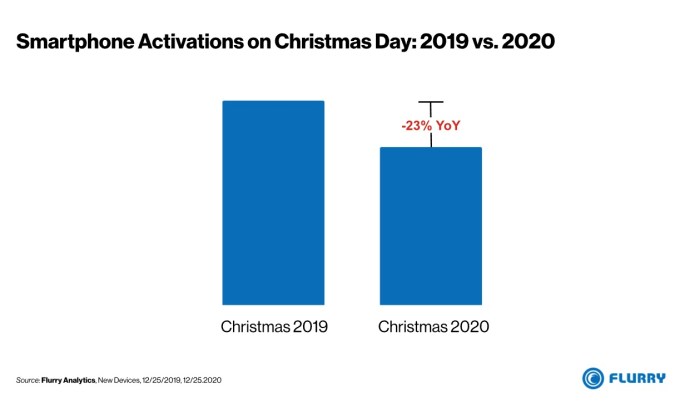
- The iPhone 11 was the most activated device on Christmas Day 2020, according to Flurry data, with activations 5% higher versus the 7 day average between December 18 to December 24. However, overall new smartphone activations were down 23% year-over-year, likely because of the economic hardships due to the COVID health crisis, including delayed stimulus checks.
- Google’s search engine on mobile devices is now aggregating short-form videos from apps including Instagram and TikTok. In select search results, Google displays a carousel of short videos in what the company says is a pilot test.
- App downloads were up 33% in 2020, up 25% compared with 2019, according to data from AppsFlyer. Mobile marketers spent $74.6B globally to drive installs, slightly down from the $74.2B spent in 2019.
- Apple patents multi-user technology for iOS. Oh please, please oh please, let this be a patent that turns into a product, begs every household with a shared iPad.
Gaming
- Samsung teams up with Epic Games on Apple battle over Fortnite. Samsung and Epic Games worked together on the “Free Fortnite” marketing campaign, which recently involving sending packages to influencers that contained a Free Fortnite bomber jacket and Samsung Galaxy Tab S7. Fortnite was the Samsung Galaxy Store game of the year in 2020, and the store also distributes the Epic Games app which distributes the Fortnite updates. This is an odd move as Epic alleges the app stores leverage their power to engage in monopolistic practices, but this makes it clear that Samsung is offering them distribution. Apple has the right to set its own pricing for its services (and it recently lowered commissions for small businesses, too). But even if Epic Games is not the knight in shining armor one would hope for, its lawsuit could help set precedent. And regulators may still decide one day that Apple can’t dictate rules about how businesses operate outside its app store — meaning, they should have the right to collect their own payments, for example.
Augmented Reality

Image Credits: The New York Times
- The New York Times gets into AR gaming. The media company has experimented with augmented reality as a way to augment storytelling both in its app and through other efforts on social media. But it has now taken AR into the world of gaming with an AR-enabled crossword puzzle where you swipe to rotate broken pieces floating above the puzzle to find clues.
Social & Photos
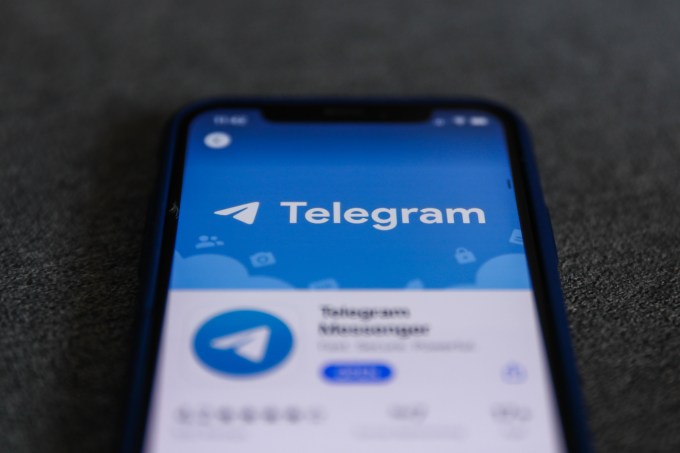
Telegram photo by Jakub Porzycki/NurPhoto via Getty Images
- Telegram begins to make money. The messaging app, now nearing 500 million users, will introduce an ad platform for its public one-to-many channels that is “user-friendly” and “respects privacy.” The company says it needs to generate revenue to cover the costs of server and traffic. Telegram earlier abandoned a blockchain token project due to regulatory issues.
- Mr. Beast announces the second annual “Finger on the App” challenge on Feb. 19. The game doles out $100,000 to whoever can keep their finger on their smartphone the longest, via an app designed for this purpose. Last year, it was a four-way tie after 70 hours, and the prize money was divided. The new app introduces in-app challenges to dissuade cheating. YouTuber Mr. Beast rose to fame for his philanthropic-based viral videos and stunts. He has made sizable donations to people in need and those impacted by the pandemic. But this year, the otherwise silly game has a darker tone as it involves competitors who will likely be in more desperate situations.
- Bumble uproar over indoor bikini and bra photos. The dating app found itself in the middle of a small controversy this week when a woman who wanted to pose in her bra had her photos taken down. The company said its existing policy prohibits things like shirtless bathroom mirror selfies and indoor photos of people wearing swimsuits and underwear. Bumble’s policies were crafted in response to user data and feedback, but may also help to prevent adult sites from spamming with fake profiles. However, there’s still something weird about an app that markets itself as female-friendly telling a woman to go put some clothes on.
- ByteDance filings reveal TikTok U.K. business recorded a $119.5 million loss over 2019. The losses were driven by advertising and marketing expenses, indicating the app is still very much in a growth mode.
- TikTok launches its first personalized annual recap feature. The company “year on TikTok” in-app experience joins other personalized wrap-ups like the Top Nine for Instagram or Spotify’s Wrapped. It also introduces a floating, tappable button to connect users to the experience. This could pave way for other sorts of mini-applications in the future.
- Clubhouse power users invited to special club. A select group of creators inside the already invite-only audio conversations app have now been given exclusive access to tools and private meetings with Clubhouse leadership and influencers. In one meeting, the creators discussed monetization strategies. The app grew to popularity amid the pandemic as people have been prevented from typical forms of networking, but it’s also struggled with moderation as conversations go off the rails. Today, Clubhouse also hosts many adult topics, as well, which would give the app a 17+ rating if it were actually submitted to the App Store instead of being in a private beta.
Streaming
- HBO Max’s mobile app set a single-day download record following the release of “Wonder Woman 1984.” During the release weekend (Fri.-Sun.) the app saw 554K downloads, including 244K downloads on Sunday alone, reported Apptopia. The firm estimates the app now has just under 12M mobile users.
Health & Fitness
Government & Policy
Security & Privacy
Funding and M&A

Image Credits: Tappity
- Tappity raises $1.3 million for its interactive and educational video library for kids. The Y Combinator-backed startup using live action actors responding to kids’ actions in the apps to teach standards-based science.
- Tencent-backed edtech startup Yuanfudao raises $300 million from Jack Ma’s Yufeng Capital. The company, which earned $1.53B USD in 2020, makes a variety of remote learning products, including live tutoring platform Yuanfudao, Zebra AI Class, online question bank Yuantiku, question searching app Xiaoyuan Souti, and arithmetic problem checking app Xiaoyuan Kousuan.
- Chinese edtech app Zuoyebang, a competitor to Yuanfudao, raises $1.6 billion in a round led by Alibaba. The company offers online courses, live lessons, and homework help for K-12, and has 170M MAUs.
- Language learning app Fluent Forever raises $4.9 million in a round led by Denver-based Stout Street Capital. A competitor to Duolingo and Babble, the app using personalized learning, ear training, visual aids, and spaced repetition to help students learn new words and phrases.
- Mobile app marketing firm Liftoff raises $400 million from New York-based investors Blackstone Group. Liftoff today delivers over a billion ads per day across over 500,000 mobile publishers.
- Dailyhunt parent company Verse Innovation raises $100 million from Google, Microsoft and Falcon Edge’s Alpha Wave Incubation, valuing its business at over $1 billion. The company will use the round to scale its short-form video app, Josh, and more.
- Mobile app marketing firm InMobi’s Glance and Roposo raise $145 million in a round led by Google. Glance makes a lockscreen that shows personalized content when the phone is lock and Roposo is a video-sharing social platform, InMobi acquired in Nov. 2019.
Downloads
Yayzy
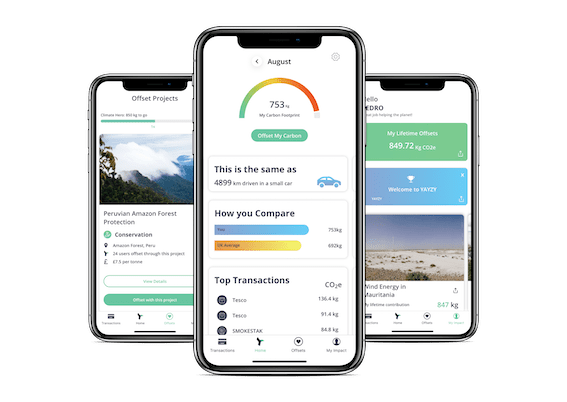
Image Credits: Yayzy
This U.K. startup’s new app will calculate the environmental impact of what you buy using payment data via Open Banking standards. You you can use this information to adjust your spending or buy offsets in-app in order to become carbon neutral. iOS only.
Waterscope
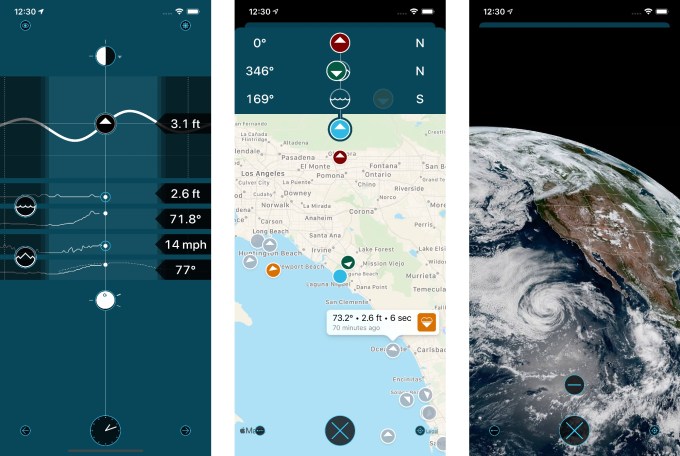
Image Credits: Iconfactory
The popular app maker Iconfactory released a new app, Waterscope, that is a weather app more specifically designed to provide users with information on water conditions. Creator Craig Hockenberry explains the app is something he largely built for himself, an ocean swimmer often in need of information about the tides, wave heights, water temperature, wind speed, air temperature, forecasts and more. The app could be useful to those who live around the water, whether they’re swimming, fishing, boating or anything else. iOS only.
Run Boggo Run

Image Credits: BuzzFeed
This endless runner is BuzzFeed’s first mobile game, which makes it worth noting if not exactly recommending. The mental health-themed game, inspired by BuzzFeed’s animated series The Land of Boggs, was created by BuzzFeed Animation Studios. In the game, characters try to avoid things like stress monsters and gremlins, which is a humorous take on the anxieties of 2020. However, early user reviews indicate the game’s controls are too difficult and complain the game is too hard to be fun. How stressful! $0.99 on iOS and Android.
Enso
A new meditation game Enso promises to help users relax, meditate or fall asleep faster using gameplay that involves soothing visuals and sounds, composed by A.I. The app consists of 5-minute journeys where users concentrate on a task while guiding their movements and breath to achieve their goals. iOS and Android.
Portal
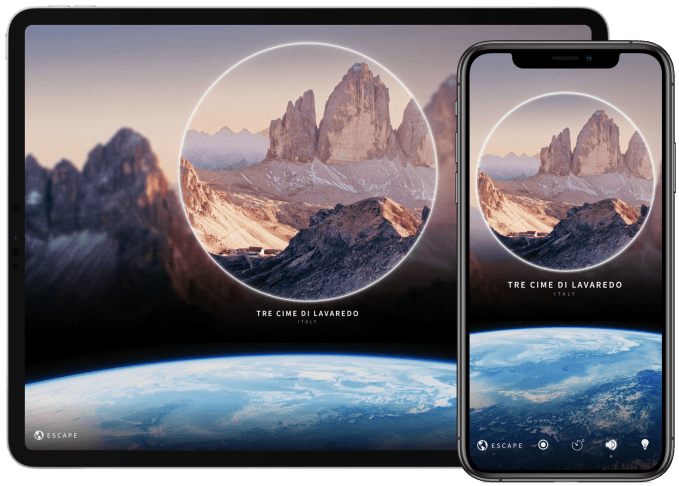
Image Credits: Portal
Not Facebook’s Portal! This sleep and relaxation-focused app, also called Portal, has been updated with Apple’s new privacy measures in mind. The company announced in December it will not collect user data from its app, and will now no longer use any in-app analytics tracking. The app also never required a login or collected personal information, and didn’t include third-party ads and ad trackers.
That’s resulted in an App Store rare find:

How refreshing.
The Portal app is a free download and offers a $35 per year membership for those who want access to the full content library.



